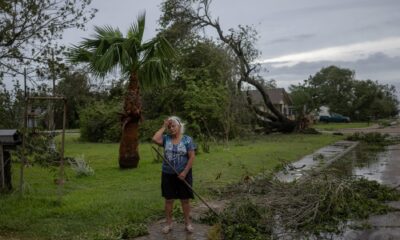A tiny, wobbly little particle might be enough to upset everything we think we know about how the universe works, according to preliminary findings released by an international team of scientists on Wednesday.
Researchers working at Fermilab near Chicago say they’ve seen strong evidence of an unknown force working at the subatomic level — a force that caused a particle to wobble in a way that it shouldn’t, based on the current understanding of physics.
“This is our Mars rover landing moment,” said Chris Polly, one of the lead scientists on the muon g-2 experiment at Fermilab.
“I feel like this tiny wobble may shake the foundations of what we thought we knew,” added Marcela Carena, head of theoretical physics at Fermilab. Carena was not part of the study but she told the New York Times that she is “very excited” by its findings.
Read more:
Proposed ‘Moon Ark’ would shoot sperm into space to save the Earth
Polly and his team saw the potentially reality-shaking wobble while shooting particles around a 14-metre-long metal ring surrounded by electromagnets, which effectively smashes things together on a teeny-tiny scale at their facility in Illinois.
The particle at the heart of the potential discovery is called a muon, and the “current understanding of physics” is called the Standard Model — a decades-old rulebook for the way that reality seems to work. The Standard Model includes a catalogue of the most basic building blocks (i.e. fundamental particles) in the universe, along with a bunch of equations describing how they interact with each other through four known forces.


Countless experiments have appeared to confirm the Standard Model over the years, but Fermilab researchers say they’ve seen muons behaving in a way that doesn’t make sense — as though they were interacting with a particle or a fifth force that we don’t understand.
The four known forces are gravity, which makes things fall on Earth; electromagnetism, which causes magnets to attract and electricity to work; the strong force, which binds atoms together; and the weak force, which is responsible for particle decay.
A new force of nature would be a huge-if-true discovery, even if we don’t fully know what it is. It could upset the entire Standard Model, although more study is needed to confirm it. The findings are expected to be published in the future.
Polly described the potential impact of the findings in a dramatic way on Wednesday.
“There might be monsters that we haven’t yet imagined that are emerging from the vacuum (and) interacting with our muons,” he said during a press conference on Wednesday. “This gives a window into seeing them.”
Researchers didn’t see any subatomic monstrosities from the void in their studies, but they did see muons wobbling faster than expected inside their giant metal racetrack.
Muons are a fundamental particle, meaning they can’t be broken down into smaller bits. They’re similar to electrons but they’re 200 times heavier and they decay within a few milliseconds. Magnets can be used to slow that decay, but the magnets also cause the muons to spin or wobble.
The Fermilab team shot the muons around their magnetized ring and studied that wobble. The muons should have wobbled at a predictable rate according to the Standard Model, but they didn’t. They wobbled a fraction of a per cent faster, which suggests that an unknown force was acting on them.
“This is strong evidence that the muon is sensitive to something that is not in our best theory,” Renee Fatemi, a physicist at the University of Kentucky, said in a news release.
“We think we might be swimming in a sea of background particles all the time that just haven’t been directly discovered,” Polly said.
The Fermilab findings strongly hint at a secret force behind the scenes, but they don’t meet the gold standard to be declared a full-blown discovery. Polly and his team say they’ll need another year or two to verify that their findings are real and not the result of a cosmically rare fluke.
“Pinning down the subtle behaviour of muons is a remarkable achievement that will guide the search for physics beyond the Standard Model for years to come,” said Fermilab’s deputy director of research, Joe Lykken. “This is an exciting time for particle physics research, and Fermilab is at the forefront.”
Researchers at the Large Hadron Collider (LHC) in Europe also found hints of an unknown force at work last month, which suggests that the Standard Model might need a rewrite. Scientists smashed together a bunch of particles called beauty quarks. They expected the collisions to produce equal amounts of electrons and muons, but they ended up producing 15 per cent more electrons than muons.
In other words, something was up.
Read more:
Massive ‘space hurricane’ discovered swirling over the North Pole
The point of both experiments, according to Johns Hopkins University theoretical physicist David Kaplan, was to pull apart particles and find out if there’s “something funny going on” with both the particles and the seemingly empty space between them.
“The secrets don’t just live in matter. They live in something that seems to fill in all of space and time. These are quantum fields,” Kaplan told the Associated Press. “We’re putting energy into the vacuum and seeing what comes out.”
He added that the results of the experiments point to something that could be explained by a new particle or force that isn’t in the Standard Model.
“This is not a fudge factor,” he said. “This is something wrong.”
— With files from The Associated Press
Must See
-




Entertainment
/ 3 days agoFaveSzn’s Revelation: Dating Choirmaster at 10 and Sexual Curiosity
Nigerian singer, Chidozie Ugochinyere, popularly known as FaveSzn, has revealed that she once dated...
By Flying Eze -






Europe
/ 3 days agoWhy Hungarian Prime Minister Orban visited
Two months later, the leaders of China and Hungary met again. Hungarian Prime Minister...
By Flying Eze -






News
/ 3 days agoThree dead and millions without power as Tropical Storm Beryl hits Texas
Man, 53, and woman, 74, killed by fallen trees and third person drowns amid...
By Flying Eze



